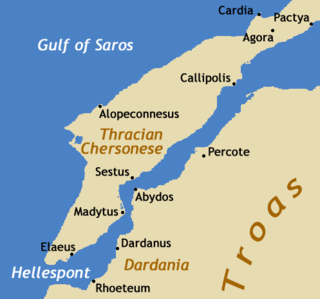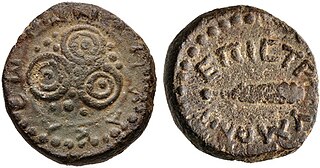Related Research Articles

Antiochus XI Epiphanes Philadelphus was a Seleucid monarch who reigned as King of Syria between 94 and 93 BC,during the Hellenistic period. He was the son of Antiochus VIII and his wife Tryphaena. Antiochus XI's early life was a time of constant civil war between his father and his uncle Antiochus IX. The conflict ended with the assassination of Antiochus VIII,followed by the establishment of Antiochus IX in Antioch,the capital of Syria. Antiochus VIII's eldest son Seleucus VI,in control of western Cilicia,marched against his uncle and had him killed,taking Antioch for himself,only to be expelled from it and driven to his death in 94 BC by Antiochus IX's son Antiochus X.

Seleucus VI Epiphanes Nicator was a Hellenistic Seleucid monarch who ruled Syria between 96 and 94 BC. He was the son of Antiochus VIII and his Ptolemaic Egyptian wife Tryphaena. Seleucus VI lived during a period of civil war between his father and his uncle Antiochus IX,which ended in 96 BC when Antiochus VIII was assassinated. Antiochus IX then occupied the capital Antioch while Seleucus VI established his power-base in western Cilicia and himself prepared for war. In 95 BC,Antiochus IX marched against his nephew,but lost the battle and was killed. Seleucus VI became the master of the capital but had to share Syria with his brother Demetrius III,based in Damascus,and his cousin,Antiochus IX's son Antiochus X.

Sestos was an ancient city in Thrace. It was located at the Thracian Chersonese peninsula on the European coast of the Hellespont,opposite the ancient city of Abydos,and near the town of Eceabat in Turkey.

Martin Litchfield West,was a British philologist and classical scholar. In recognition of his contribution to scholarship,he was awarded the Order of Merit in 2014.
The Garigliano bowl is a small impasto bowl with bucchero glaze likely to have been produced around 500 BC,with an early Latin inscript written in a form of the western Greek or Etruscan alphabet. It was found along the river Garigliano,between Lazio and Campania,in the vicinity of ancient Minturnae,in the ancient territory occupied by the Aurunci.

The Derveni papyrus is an ancient Greek papyrus roll that was found in 1962. It is a philosophical treatise that is an allegorical commentary on an Orphic poem,a theogony concerning the birth of the gods,produced in the circle of the philosopher Anaxagoras. The roll dates to around 340 BC,during the reign of Philip II of Macedon,making it Europe's oldest surviving manuscript. The poem itself was composed near the end of the 5th century BC,and "in the fields of Greek religion,the sophistic movement,early philosophy,and the origins of literary criticism it is unquestionably the most important textual discovery of the 20th century." While interim editions and translations were published over the subsequent years,the manuscript as a whole was finally published in 2006.
Peter Sidney Derow was Hody Fellow and Tutor in Ancient History at Wadham College,Oxford and University Lecturer in Ancient History from 1977 to 2006. As a scholar he was most noted for his work on Hellenistic and Roman Republican history and epigraphy,particularly on the histories of Polybius.
In ancient Greece the chief magistrate in various Greek city states was called eponymous archon. "Archon" means "ruler" or "lord",frequently used as the title of a specific public office,while "eponymous" means that he gave his name to the year in which he held office,much like the Roman dating by consular years.

Heraclea Sintica,also known as Heraclea Strymonike,was an ancient Greek city located near what is now the village of Rupite in south-western Bulgaria.
Adrian Swayne Hollis was an English classical scholar and correspondence chess grandmaster,the title having been awarded in 1976.

Totenpass is a German term sometimes used for inscribed tablets or metal leaves found in burials primarily of those presumed to be initiates into Orphic,Dionysiac,and some ancient Egyptian and Semitic religions. The term may be understood in English as a "passport for the dead". The so-called Orphic gold tablets are perhaps the best-known example.
Richard Charles Murray Janko is an Anglo-American classical scholar and the Gerald F. Else Distinguished University Professor of Classical Studies at the University of Michigan.
Marcus Lollius was a Roman Senator who was active in the second half of 1st century BC and first half of 1st century. He is best remembered as the father of empress Lollia Paulina.
Peter Allan Hansen was a Danish classical philologist known principally for his work on the Carmina epigraphica graeca I-II and on other aspects of Greek epigraphy. Born in Copenhagen he was educated at Copenhagen University and at Brasenose College,Oxford,where he was a pupil of Lilian H. Jeffery. After 1975 he settled in Oxford and through the support of scholarships and grants continued his work on Hesychios and epigraphy there.
Stephen Victor Tracy is an American scholar of Classics specializing in ancient Greek Epigraphy. Inscriptions are one of the most important classes of primary evidence that comes down to us from antiquity. Tracy is best known for devising a method for recognizing the work of individual inscribers. It was long thought that the intractability of the medium made this impossible. But by treating the inscribed letters as a kind of handwriting he has been able to establish careers for many cutters,to join discrete fragments,to date inscriptions more accurately than in the past,and often thereby make it possible to reach a new understanding of historical events.
Susan Guettel Cole is Professor Emerita at the University at Buffalo in the Department of Classics. She is known for her work on Ancient Greek Religion and gender.
The Philinna Papyrus is part of a collection of ancient Greek spells written in hexameter verse. Three spells are partially preserved on the papyrus. One is a cure for headache,one probably for a skin condition,and the purpose of the third spell is uncertain. Two fragments of the papyrus survive,in the collections of the Morgan Library &Museum,New York,and the Berlin State Museums.
References
- 1 2 3 4 "Sheila Ager". Classical Studies. May 13, 2013.
- ↑ "Sheila L. Ager". www.librarything.com.
- 1 2 "Professor Spotlight: Sheila Ager". Arts Computing Office Newsletter. 2019-08-16. Retrieved 2021-03-16.
- 1 2 "Sheila Ager named Dean of Arts". Arts. 2019-03-27. Retrieved 2021-03-16.
- ↑ "Sheila Ager named Hyde Lecturer for Spring 2020 | Department of Classical Studies". www.classics.upenn.edu. Retrieved 2021-03-16.
- ↑ Ager, Sheila; Faber, Reimer (2016-04-11). Belonging and Isolation in the Hellenistic World. University of Toronto Press. doi:10.3138/9781442699441. ISBN 978-1-4426-9944-1.
- ↑ Chaniotis, Angelos (October 1997). "Review of Interstate Arbitration in the Greek World, 337-90 B.C. (Hellenistic Culture and Society, 18)". Bryn Mawr Classical Review. Retrieved 2021-03-16.
- ↑ Wheeler, Everett L. (1998). "Interstate Arbitrations in the Greek World, 337-90 B.C. (review)" (PDF). American Journal of Philology. 119 (4): 642–646. doi:10.1353/ajp.1998.0045. ISSN 1086-3168.
- ↑ Erskine, Andrew (1998). "S. L. Ager, Interstate Arbitrations in the Greek World, 337–90 B.C.Berkeley/Los Angeles/London: University of California Press, 1996. Pp. xvii + 579. ISBN 0-520-08162-5. £55.00/US$70.00". Journal of Roman Studies. 88: 190–191. doi:10.2307/300826. ISSN 0075-4358. JSTOR 300826.